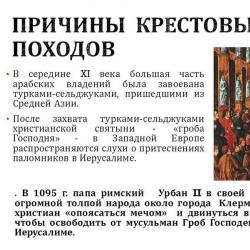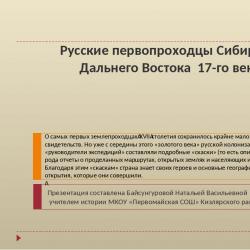Mechanical work. School encyclopedia What is work in physics
Class
Lesson #27
Mechanical work. Power Units of their measurement.
Learning new material
Job". This word has been familiar to us since childhood. It accompanies us throughout life; this word we call any kind of human activity: physical, mental or creative. We know that during life the heart does work. This work of the heart is equivalent to the work that must be done to lift the train to the highest mountain in Europe - Mont Blanc (4810 m). All living things are constantly moving, a person only in his activity develops and achieves his results. This is an important concept.
But physics puts a slightly different content into this concept. In physics, mechanical work is primarily studied. And a very important fact when doing work is its speed. We always want to do something not only better, but also faster.
At the moment I will ask you to demonstrate the performance of some work in their places. Please tell me what is the necessary condition for the work to be done?
Yes, the presence of applied force and displacement.
Mechanical work is a physical quantity that characterizes the movement of a body under the action of a force.
Like any other physical quantity, mechanical work has units of measurement and a formula for calculation.
[A] = 1 J
Mechanical work is equal to the product of force and displacement.
« This is interesting!" The SI unit of work is named after the 19th-century English scientist J. Joule. J. Joule (1818-1889) was born in England in the family of a brewery owner. Due to poor health, James did not attend school until the age of 15. But at the age of 15, under the guidance of the famous chemist John Dalton, he successfully mastered mathematics, physics and chemistry. After the death of his father, having sold his part of the inheritance, Joule began independent scientific research, investing all his money in it. In his lifetime, Joule conducted a thousand experiments in the field of mechanics, electromagnetism and thermal phenomena, which were successful.
Now let's take a look at an example of a job. You need to dig up the area. How to do this job faster - with a shovel or a tractor? Will the work done be the same?
Yes, the work is the same; but different time will be spent: this work will be done faster by the tractor.
We will go up to the 10th floor faster by elevator than by stairs. A crane lifts a heavy brick to the height of a house under construction in a few minutes, while workers would spend a whole day doing the same work. The mechanism that does the work faster is considered more powerful.
Power is a physical quantity that characterizes the rate at which work is done.
Power is equal to the ratio of mechanical work to the time for which this work is done.
The unit of power is named after the English scientist James Watt. He was called the "Archimedes" of the 18th century. But there is an off-system unit of power measurement - horsepower. The fact is that at the dawn of mechanical engineering, a potential consumer was more familiar and more understandable with the explanation that the power of this mechanism is 20 horsepower, that is, the mechanism is capable of replacing 20 horses.
« This is interesting!" The average power of an adult with a sufficiently long work is approximately 35 - 75 watts. But in a fairly short time, a person can develop more power than a horse. For example, athletes who push a barbell weighing more than 200 kg to a height of 1.8 m in 1 s develop approximately 3500 watts of power.
With the help of calculations in your notebooks, you can verify this fact.
And the power of an insect in flight is approximately 0.00001 watts.
Consolidation of new material.
The solution of the problem
What power does a weightlifter develop if he lifts a barbell weighing 125 kg to a height of 70 cm in 0.3 s?
Given: SI Solution
t=125kg
h=70cm 0.7m N= but A=FS and F=mg and S=h.
t=0.3s So N=
N-? N= 2916.7 W
[N] = = = =W
Answer: 2916.7 W.
Homework
8-a: learn paragraphs 17 and 19 (item 3); answer questions in writing.
8-b: learn paragraphs 41 and 47; answer questions in writing.
Questions
1. Give examples when a force acts on the body, but it does not do work.
2. Two loads of the same weight were delivered by buses to a suburban settlement of Donetsk and to the center of Donetsk. Was the work done in the first and second cases the same? Why?
3. Why did construction begin faster in the 20th and 21st centuries than before?
4. Two boys of different weights raced out to the third floor of the house, showing the same time. Did they develop the same power at the same time?
Note that work and energy have the same unit of measure. This means that work can be converted into energy. For example, in order to lift a body to a certain height, then it will have potential energy, a force is needed that will do this work. The work of the lifting force will be converted into potential energy.
The rule for determining work according to the dependency graph F(r): work is numerically equal to the area of the figure under the graph of force versus displacement.

Angle between force vector and displacement
1) Correctly determine the direction of the force that does the work; 2) We depict the displacement vector; 3) We transfer the vector to one point, we get the desired angle.

In the figure, the body is affected by gravity (mg), support reaction (N), friction force (Ftr) and rope tension force F, under the influence of which the body moves r.
The work of gravity

Support reaction work

The work of the friction force

Rope tension work

The work of the resultant force
The work of the resultant force can be found in two ways: 1 way - as the sum of the work (taking into account the signs "+" or "-") of all forces acting on the body, in our example
Method 2 - first of all, find the resultant force, then directly its work, see figure

The work of the elastic force
To find the work done by the elastic force, it is necessary to take into account that this force changes, since it depends on the elongation of the spring. From Hooke's law it follows that with an increase in absolute elongation, the force increases.
To calculate the work of the elastic force during the transition of a spring (body) from an undeformed state to a deformed one, use the formula


Power
A scalar value that characterizes the speed of doing work (an analogy can be drawn with acceleration, which characterizes the speed of change in speed). Determined by the formula


Efficiency
Efficiency is the ratio of the useful work done by the machine to all the work expended (energy supplied) for the same time


The efficiency factor is expressed as a percentage. The closer this number is to 100%, the better the performance of the machine. There cannot be an efficiency greater than 100, since it is impossible to do more work with less energy.
The efficiency of an inclined plane is the ratio of the work done by gravity to the work expended in moving along an inclined plane.
The main thing to remember
1) Formulas and units of measurement;
2) Work is done by force;
3) Be able to determine the angle between the vectors of force and displacement
If the work of a force when moving a body along a closed path is zero, then such forces are called conservative or potential. The work of the friction force when moving a body along a closed path is never equal to zero. The force of friction, in contrast to the force of gravity or the force of elasticity, is non-conservative or non-potential.
There are conditions under which the formula cannot be used ![]()
If the force is variable, if the trajectory of motion is a curved line. In this case, the path is divided into small sections for which these conditions are met, and elementary work on each of these sections is calculated. The total work in this case is equal to the algebraic sum of elementary works: 
The value of the work of some force depends on the choice of the reference system.
mechanical work- this is a physical quantity - a scalar quantitative measure of the action of a force (resultant force) on a body or forces on a system of bodies. Depends on the numerical value and direction of the force (forces) and on the displacement of the body (system of bodies).
Notation used
Work is usually denoted by the letter A(from him. A rbeit- work, labor) or a letter W(from English. w ork- work, work).
Definition
The work of a force applied to a material point
The total work to move one material point, performed by several forces applied to this point, is defined as the work of the resultant of these forces (their vector sum). Therefore, we will continue to talk about one force applied to a material point.
With a rectilinear motion of a material point and a constant value of the force applied to it, the work (of this force) is equal to the product of the projection of the force vector on the direction of movement and the length of the displacement vector made by the point:
A = F s s = F s c o s (F , s) = F → ⋅ s → (\displaystyle A=F_(s)s=Fs\ \mathrm (cos) (F,s)=(\vec (F))\ cdot(\vec(s))) A = ∫ F → ⋅ d s → . (\displaystyle A=\int (\vec (F))\cdot (\vec (ds)).)(summation along the curve is implied, which is the limit of a broken line made up of successive displacements d s → , (\displaystyle (\vec (ds)),) if we first consider them finite, and then let the length of each tend to zero).
If there is a dependence of the force on the coordinates, the integral is defined as follows:
A = ∫ r → 0 r → 1 F → (r →) ⋅ d r → (\displaystyle A=\int \limits _((\vec (r))_(0))^((\vec (r)) _(1))(\vec (F))\left((\vec (r))\right)\cdot (\vec (dr))),Where r → 0 (\displaystyle (\vec(r))_(0)) And r → 1 (\displaystyle (\vec(r))_(1)) are the radius vectors of the initial and final position of the body, respectively.
- Consequence. If the direction of the applied force is orthogonal to the displacement of the body or the displacement is zero, then the work (of this force) is zero.
The work of forces applied to a system of material points
The work of forces in moving a system of material points is defined as the sum of the work of these forces in moving each point (the work done on each point of the system is summed up in the work of these forces on the system).
Even if the body is not a system of discrete points, it can be divided (mentally) into many infinitesimal elements (pieces), each of which can be considered a material point, and work can be calculated in accordance with the definition above. In this case, the discrete sum is replaced by an integral.
- These definitions can be used both to calculate the work of a particular force or class of forces, and to calculate the total work done by all forces acting on the system.
Kinetic energy
E k = 1 2 m v 2 . (\displaystyle E_(k)=(\frac (1)(2))mv^(2).)For complex objects consisting of many particles, the kinetic energy of the body is equal to the sum of the kinetic energies of the particles.
Potential energy
Work in thermodynamics
In thermodynamics, the work done by a gas during expansion is calculated as the integral of pressure over volume:
A 1 → 2 = ∫ V 1 V 2 P d V . (\displaystyle A_(1\rightarrow 2)=\int \limits _(V_(1))^(V_(2))PdV.)
The work done on the gas coincides with this expression in absolute value, but is opposite in sign.
- The natural generalization of this formula is applicable not only to processes where pressure is a single-valued function of volume, but also to any process (depicted by any curve in the plane PV), in particular, to cyclic processes.
- In principle, the formula is applicable not only to gas, but also to anything capable of exerting pressure (it is only necessary that the pressure in the vessel be the same everywhere, which is implicitly implied in the formula).
This formula is directly related to mechanical work. Indeed, let's try to write the mechanical work during the expansion of the vessel, given that the gas pressure force will be directed perpendicular to each elementary area, equal to the product of pressure P To the square dS platforms, and then the work done by the gas to displace h one such elementary site will be
d A = P d S h . (\displaystyle dA=PdSh.)It can be seen that this is the product of pressure and volume increment near a given elementary area. And summing over all dS, we will get the final result, where there will already be a full increase in volume, as in the main formula of the section.
Work of force in theoretical mechanics
Let us consider in more detail than it was done above the construction of the definition of energy as a Riemannian integral.
Let the material point M (\displaystyle M) moves along a continuously differentiable curve G = ( r = r (s) ) (\displaystyle G=\(r=r(s)\)), where s is the variable length of the arc, 0 ≤ s ≤ S (\displaystyle 0\leq s\leq S), and it is acted upon by a force directed tangentially to the trajectory in the direction of motion (if the force is not directed tangentially, then we will understand by F (s) (\displaystyle F(s)) projection of the force onto the positive tangent of the curve, thus reducing this case to the one considered below). Value F (ξ i) △ s i , △ s i = s i − s i − 1 , i = 1 , 2 , . . . , i τ (\displaystyle F(\xi _(i))\triangle s_(i),\triangle s_(i)=s_(i)-s_(i-1),i=1,2,... ,i_(\tau )), is called elementary work strength F (\displaystyle F) on the site and is taken as an approximate value of the work that the force produces F (\displaystyle F) acting on the material point when the latter passes the curve G i (\displaystyle G_(i)). The sum of all elementary works is the Riemann integral sum of the function F (s) (\displaystyle F(s)).
In accordance with the definition of the Riemann integral, we can define work:
The limit to which the sum tends ∑ i = 1 i τ F (ξ i) △ s i (\displaystyle \sum _(i=1)^(i_(\tau ))F(\xi _(i))\triangle s_(i)) of all elementary works, when pettiness | τ | (\displaystyle |\tau |) partitions τ (\displaystyle \tau ) tends to zero is called the work done by the force. F (\displaystyle F) along the curve G (\displaystyle G).
Thus, if we denote this work by the letter W (\displaystyle W), then, by this definition,
W = lim | τ | → 0 ∑ i = 1 i τ F (ξ i) △ s i (\displaystyle W=\lim _(|\tau |\rightarrow 0)\sum _(i=1)^(i_(\tau ))F( \xi _(i))\triangle s_(i)),hence,
W = ∫ 0 s F (s) d s (\displaystyle W=\int \limits _(0)^(s)F(s)ds) (1).If the position of a point on the trajectory of its movement is described using some other parameter t (\displaystyle t)(for example, time) and if the distance traveled s = s (t) (\displaystyle s=s(t)), a ≤ t ≤ b (\displaystyle a\leq t\leq b) is a continuously differentiable function, then from formula (1) we obtain
W = ∫ a b F [ s (t) ] s ′ (t) d t . (\displaystyle W=\int \limits _(a)^(b)Fs"(t)dt.)Dimension and units
The unit of measure for work in the International System of Units (SI) is
One of the most important concepts in mechanics work force .
Force work

All physical bodies in the world around us are driven by force. If a moving body in the same or opposite direction is affected by a force or several forces from one or more bodies, then they say that work is done .
That is, mechanical work is done by the force acting on the body. Thus, the traction force of an electric locomotive sets the entire train in motion, thereby performing mechanical work. The bicycle is propelled by the muscular strength of the cyclist's legs. Therefore, this force also does mechanical work.
In physics work of force called a physical quantity equal to the product of the modulus of force, the modulus of displacement of the point of application of force and the cosine of the angle between the vectors of force and displacement.
A = F s cos (F, s) ,
Where F modulus of force,
s- movement module .
Work is always done if the angle between the winds of force and displacement is not equal to zero. If the force acts in the opposite direction to the direction of motion, the amount of work is negative.
Work is not done if no forces act on the body, or if the angle between the applied force and the direction of motion is 90 o (cos 90 o \u003d 0).
If the horse pulls the cart, then the muscular force of the horse, or the traction force directed in the direction of the cart, does the work. And the force of gravity, with which the driver presses on the cart, does no work, since it is directed downward, perpendicular to the direction of movement.
The work of a force is a scalar quantity.
SI unit of work - joule. 1 joule is the work done by a force of 1 newton at a distance of 1 m if the direction of force and displacement are the same.
If several forces act on a body or material point, then they talk about the work done by their resultant force.
If the applied force is not constant, then its work is calculated as an integral:
![]()
Power

The force that sets the body in motion does mechanical work. But how this work is done, quickly or slowly, is sometimes very important to know in practice. After all, the same work can be done in different times. The work that a large electric motor does can be done by a small motor. But it will take him much longer to do so.
In mechanics, there is a quantity that characterizes the speed of work. This value is called power.
Power is the ratio of the work done in a certain period of time to the value of this period.
N= A /∆ t
A-priory A = F s cos α , A s/∆ t = v , hence
N= F v cos α = F v ,
Where F - force, v speed, α is the angle between the direction of the force and the direction of the velocity.
That is power - is the scalar product of the force vector and the velocity vector of the body.
In the international SI system, power is measured in watts (W).
The power of 1 watt is the work of 1 joule (J) done in 1 second (s).
Power can be increased by increasing the force that does the work, or the rate at which this work is done.
What does it mean?
In physics, "mechanical work" is the work of some force (gravity, elasticity, friction, etc.) on the body, as a result of which the body moves.
Often the word "mechanical" is simply not spelled.
Sometimes you can find the expression "the body has done the work", which basically means "the force acting on the body has done the work."
I think - I'm working.
I go - I also work.
Where is the mechanical work here?
If a body moves under the action of a force, then mechanical work is done.
The body is said to do work.
More precisely, it will be like this: the work is done by the force acting on the body.
Work characterizes the result of the action of a force.
The forces acting on a person do mechanical work on him, and as a result of the action of these forces, the person moves.

Work is a physical quantity equal to the product of the force acting on the body and the path taken by the body under the action of the force in the direction of this force.

A - mechanical work,
F - strength,
S - the distance traveled.
Work is done, if 2 conditions are met simultaneously: a force acts on the body and it
moves in the direction of the force.

Work is not done(i.e. equal to 0) if:
1. The force acts, but the body does not move.
For example: we act with force on a stone, but we cannot move it.

2. The body moves, and the force is equal to zero, or all forces are compensated (ie, the resultant of these forces is equal to 0).
For example: when moving by inertia, no work is done.
3. The direction of the force and the direction of motion of the body are mutually perpendicular.
For example: when a train moves horizontally, gravity does no work.
Work can be positive or negative.
1. If the direction of the force and the direction of motion of the body are the same, positive work is done.
For example: gravity, acting on a drop of water falling down, does positive work.
2. If the direction of the force and the movement of the body are opposite, negative work is done.
For example: the force of gravity acting on a rising balloon does negative work.
If several forces act on a body, then the total work of all forces is equal to the work of the resulting force.
Units of work
In honor of the English scientist D. Joule, the unit of work was named 1 Joule.
In the international system of units (SI):
[A] = J = N m
1J = 1N 1m
Mechanical work is equal to 1 J if, under the influence of a force of 1 N, the body moves 1 m in the direction of this force.
When flying from the thumb of a person to the index
a mosquito does work - 0,000,000,000,000,000,000,000,000,001 J.
The human heart performs approximately 1 J of work in one contraction, which corresponds to the work done when lifting a load of 10 kg to a height of 1 cm.
TO WORK, FRIENDS!






